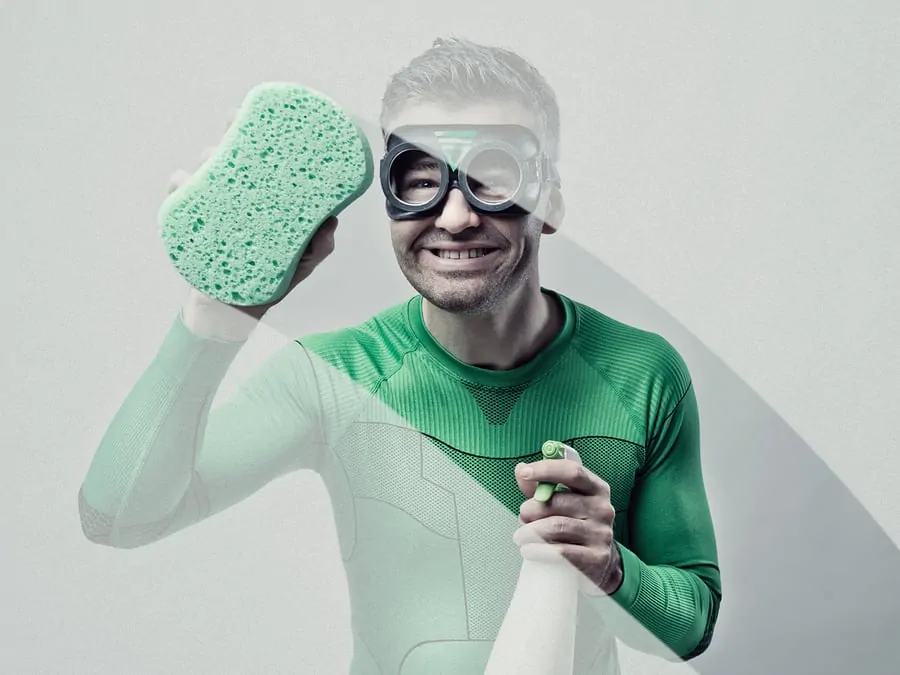How clean are your cleaners? In many cases, germs are safer than the toxins found in traditional cleaners. Chemical-filled disinfectants are a part of nearly every household. And, commercial advertisements lead us to believe that chemicals are the only true way to effectively deep clean.
Most households have a cabinet full of cleaners that are laden with chemicals that may appear to keep germs at bay, but actually negatively impact your health and the environment. From respiratory irritants to neurotoxins to hormone disruptors to carcinogens, mainstream cleaning products do more harm than good.
Does this mean you can’t keep your home clean and minimize germs? No way! However, the green earth natural cleaners that line store shelves may still contain chemicals and come with large price tags. Save both your health and wallet by making super easy, effective, inexpensive cleaners yourself.
You probably already have all of the homemade cleaner players sitting in your cabinet. Vinegar, baking soda, essential oils, castile soap, and lemon juice are all you’ll need. Whip out a scrub brush, sponge, spray bottle, mixing bowl, and paper towels, too, and your house will be sparkling and germ-free in no time!

4 Powerful Chemical-Free Ingredients
Distilled White Vinegar
This is a cheap all-purpose acidic cleaner that can help remove stains and scum, eliminate odors, and degrease surfaces. It can be combined with essential oils to enhance its germ-reducing properties and minimize its strong smell.
Baking Soda
This naturally occurring alkaline substance helps dissolve and lift dirt and grease, and brighten surfaces. The powdery substance is a gentle abrasive that is safe to use on most surfaces when scrubbing is needed. And, baking soda gets it deodorizing property by neutralizing odors rather than masking them.
Essential Oils
These potent plant-based oils contain naturally occurring antibacterial, antiviral, and antifungal properties. They work synergistically with other non-toxic cleaning ingredients to sanitize while contributing pleasant, uplifting scents. Essential oils are made by distilling plant constituents such as leaves, stems, flowers, bark, and roots.
Although essential oils are natural, they are very concentrated and can trigger allergies, so always use caution and avoid direct contact with skin.
Castile Soap
This is a versatile, mild soap that is thought to have originated in Spain (Castile region). It is made from plant oils—traditionally olive oil was used—such as coconut oil, hemp oil, palm kernel oil, and jojoba oil. Castile soap’s surfactant properties make it useful for lifting dirt and degreasing surfaces. And it’s biodegradable.
Lemon Juice
This is acidic, and helps conquer mold and mildew. Lemon juice degreases and brightens surfaces, and has antiseptic properties as well.
Super Simple Non-toxic Cleaner Recipes for a Healthy Home
Daily Toilet Bowl Cleaner
Fill a spray bottle with vinegar and add essential oils that are naturally antibacterial such as lemon and melaleuca (tea tree). Adjust the drops of essential oil to the amount of vinegar your spray bottle holds: 7 drops per cup of vinegar. Spray your toilet with the mixture and wipe clean with a paper towel.
Deep Cleaning and Whitening Toilet Bowl Cleaner
This uses the reaction between baking soda and vinegar to create a fizzing cleaner that removes stains while deep cleaning. Measure ½ cup of baking soda and pour it into the toilet. Add 10 drops of melaleuca essential oil (tea tree oil) and 5 drops of lemon essential oil.
To activate the fizzing, add ¼ cup of vinegar to the toilet bowl, and then use a toilet brush to clean the inside of the toilet. Use caution when adding vinegar to prevent the fizz from getting in your eyes.
Daily Shower Spray
Fill a spray bottle with vinegar. Add essential oils that are naturally antibacterial—for example, eucalyptus and melaleuca essential oil (tea tree). Adjust the drops of essential oil to the amount of vinegar your spray bottle holds: 7 drops per cup of vinegar. Spray the tub and shower walls after showering to minimize mildew and prevent soap scum from accumulating.
You can also spray shower doors and then wipe clean with a squeegee.
Soft Scrub
Combine ¾ cup of baking soda, 2 tablespoons of unscented castile soap, and 10-15 drops of essential oil (I like a combination of lemon, orange, grapefruit, and melaleuca). Slowly stir in water 1 tablespoon at a time (about 2 ½ tablespoons) until a spreadable paste forms. Pour or scoop mixture onto the surface and scrub with a brush or sponge, working into the surface to lift deep stains. Repeat this process, if needed.
Remove excess soft scrub with a sponge or paper towel and then wipe down with warm water. To prevent it from drying out, make the paste right before use. Otherwise, be sure to store it in a sealed container at room temperature. For an easy “pre-made mix,” you can mix together the baking soda, essential oils, and castile soap, and then add water right before you’re ready to clean.
Glass and Mirror Cleaner
Add a ½ cup of vinegar and a ½ cup of distilled water to a spray bottle. If you wish, you may add 5 drops of lemon and 5 drops of orange essential oils for a clean, energizing scent. Spray and wipe with a cloth.
Wood Cutting Boards Cleaner
To sanitize, slice a lemon in half and rub it all over the cutting board and wipe it clean with a cloth. For a deeper cleaning and to remove stains, squeeze lemon juice directly on the cutting board, rub all over, and let it sit for 10-15 minutes. Then, rub the sliced lemon all over the cutting board again and wipe it clean with a cloth.
Heat-Resistant Glassware Stain Remover
Boil two cups of water and ¼ cup of vinegar. Pour into the glassware and let soak for 15 minutes. Use the abrasive side of a sponge to wipe it clean and then wash glassware with water.
Foaming Liquid Hand Soap
To an 8-ounce glass Mason jar, add ½ cup of distilled water. Add to this (you want to follow the order of water first and then soap to prevent suds from forming) ½ cup of unscented castile soap, ½ tablespoon of vitamin E, ½ tablespoon of vegetable glycerin (or use extra castile soap), 1 tablespoon of olive oil (or any combination of olive, jojoba, and sweet almond oils), and essential oils of your preference.
I like the following essential oil combinations: (a) 6 drops of spearmint, 6 drop of peppermint, 20 drops of rosemary, and 5 drops of cedarwood; (b) 12 drops of grapefruit, 15 drops of rosemary, and 6 drops of ylang ylang. Screw on a foam pump top to the Mason jar. When ready to use, gently shake the Mason jar, pump a dime-sized amount into your hands, scrub hands together, and rinse with water.
Linen Spray
In a small mixing bowl or a large cup, mix 2 tablespoons of witch hazel, 6 tablespoons of distilled water, and 48 drops of lavender essential oil until evenly combined. Pour into a 4-ounce glass spray bottle. For best results, spray onto linens from 6 inches away to freshen them in the morning or before bed. Can also be sprayed in closets to freshen clothes.
Although this is safe for fabrics and furnishing, always be sure to test a small spot on linens and clothing to avoid any potential staining.
The Takeaway
Traditional cleaners may appear to make surfaces clean, but they’re filled with harmful chemicals that damage your health and the environment. However, keeping your home clean with non-toxic cleaners is inexpensive and simpler than you think. Some of the most basic ingredients already in your home make the most effective cleaners with antibacterial, antiviral, and antifungal properties that not only lift dirt but brighten surfaces.
*****************
 Christine Cherpak is a health coach and yoga teacher who nourishes the human spirit and celebrates the rhythms of life. Freeing herself of food allergy restraints and claiming her true self, Christine empowers others to achieve a balanced state while learning to live, play, and love food again. Learn more about Christine by visiting Kalena Spire and Pinterest.
Christine Cherpak is a health coach and yoga teacher who nourishes the human spirit and celebrates the rhythms of life. Freeing herself of food allergy restraints and claiming her true self, Christine empowers others to achieve a balanced state while learning to live, play, and love food again. Learn more about Christine by visiting Kalena Spire and Pinterest.
